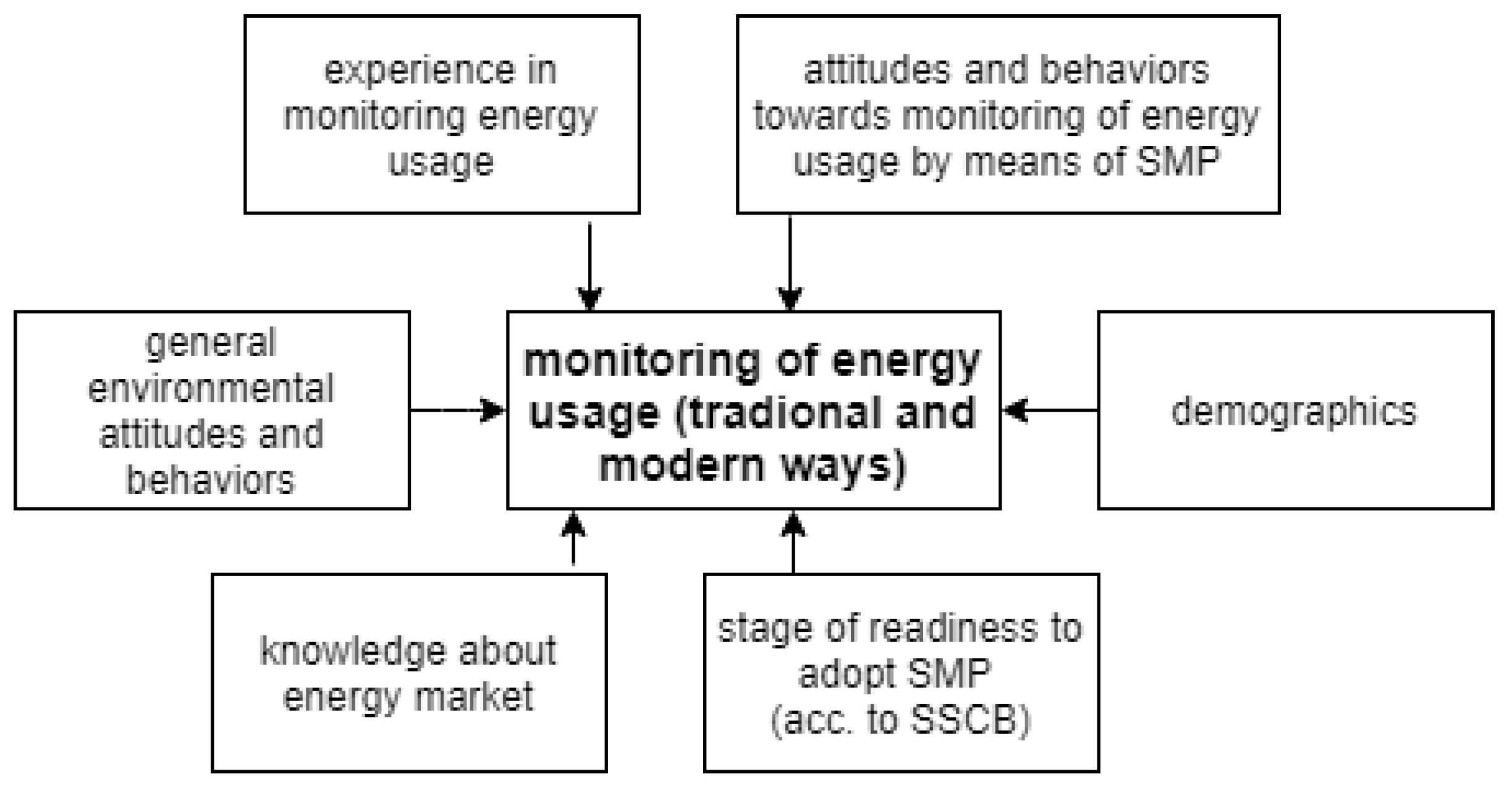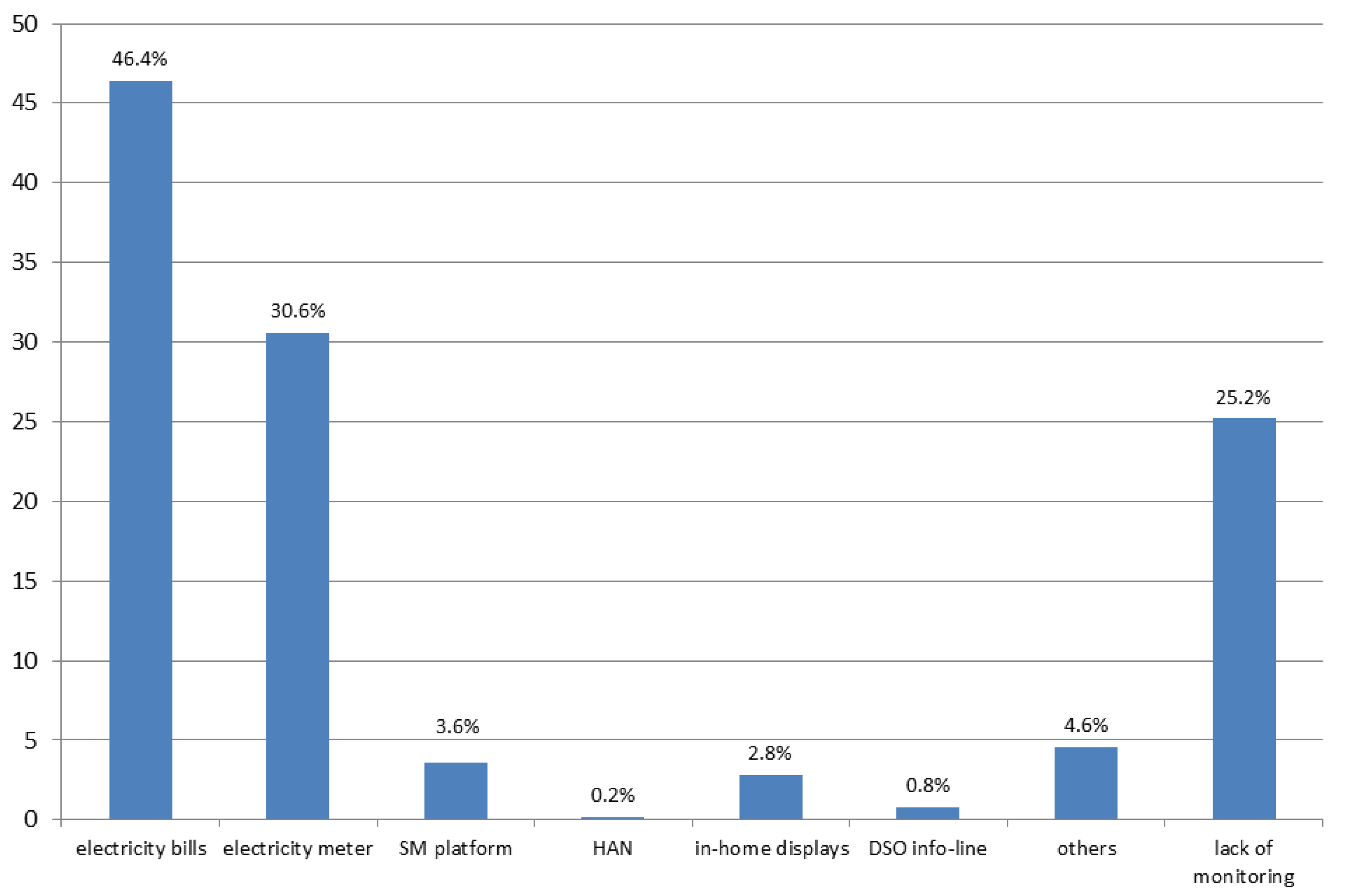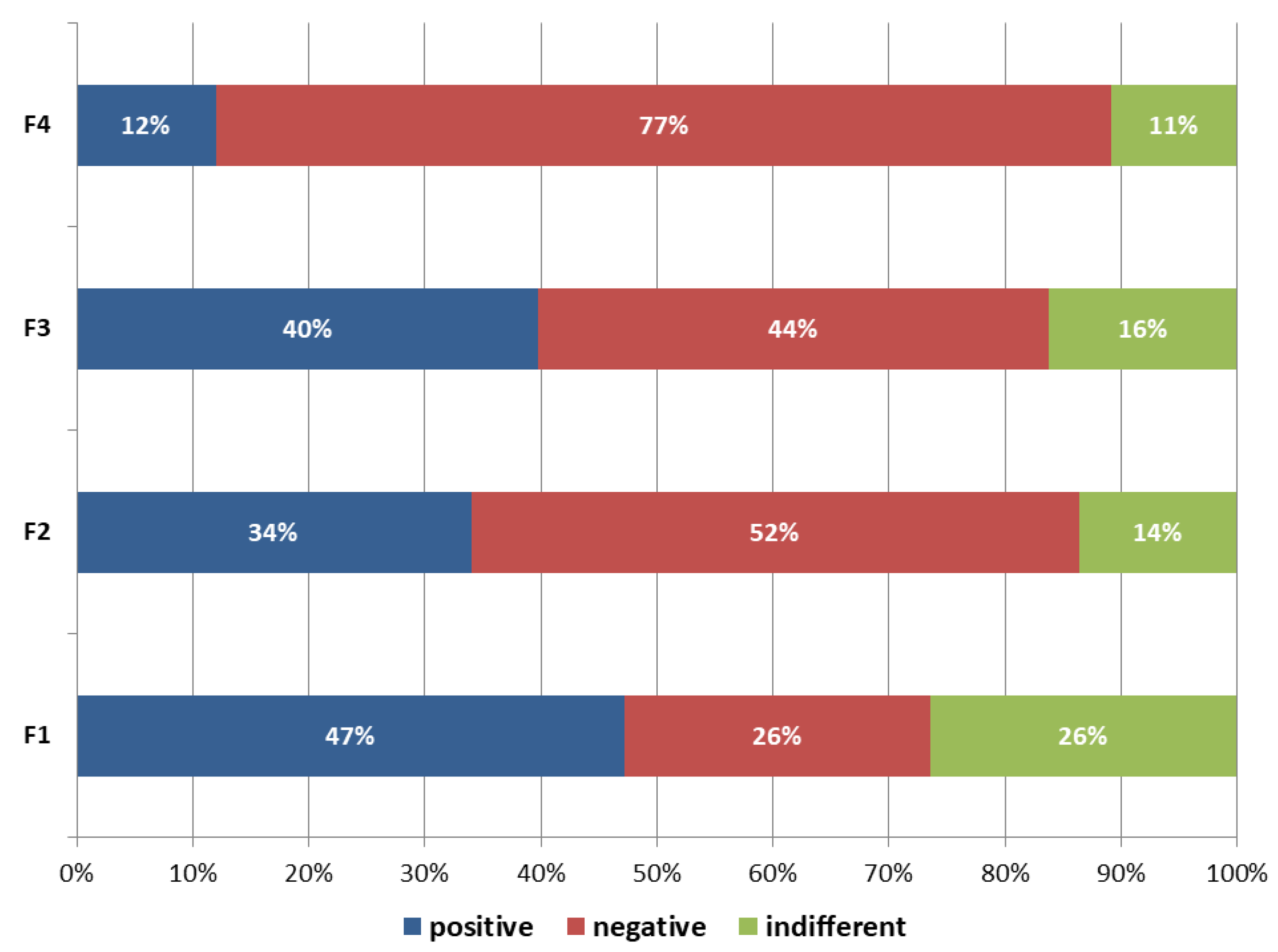To explore the determinants of the willingness to monitor energy usage, in general and via SMP, we performed following statistical analyses. First, in order to describe the sample and show relations between the chosen variables, descriptive statistics and pairwise analysis of correlation were used. Then, to explore the predictors of the endorsement of the stages of readiness to adopt SMP (F1–F4) the logistic regression models were performed. All calculations have been performed in SPSS statistical program.
4.1. Monitoring of Energy Usage
First, based on the questions regarding monitoring behaviors, it was found that almost one quarter of the respondents do not monitor their energy consumption at all (see
Figure 2). Out of those who reported to monitor energy consumption, 46.4% monitors their consumption by the means of the electricity bills. One third, (30.6%) uses information from traditional and smart electricity meters. Very few of the respondents have already used SM platform (3.6%), home area network (HAN) (0.2%) or in-home displays (2.8%). The monitoring activities mentioned by the respondents in the category “others” included: turning off the lights, avoiding keeping home appliances in stand-by mode, using a washing-machine and a washer when they are fully loaded, or investments in energy efficient home appliances. As one may notice these reported activities aim rather at energy reduction than at monitoring by itself.
Second, to investigate respondents’ attitudes regarding energy monitoring in general and by means of SMP we asked 15 questions, inspired by other studies [
26,
65]. In particular we wanted to explore: (M1) problem awareness, (M2) personal responsibility, (M3) personal norms, (M4) social norm, (M5) positive emotions, (M6) negative emotions, (M7) perceived behavioral control or goal feasibility, (M8) goal intention, (M9) attitudes, (M10) behavioral intention, (M11) action plan, (M12) coping plan, (M13) maintenance efficacy, (M14) implementation intention, (M15) recovery efficacy, see
Table 3.
Most of the respondents revealed rather positive attitudes and emotions towards monitoring (M1–M3, M5) with the mean value above M = 4.0. Most of the respondents (66%) declared to have intention to contribute to environmental protection by regular monitoring of energy usage (M9). At the same time 37% of them have not started any monitoring energy consumption (E6).
In case when the respondents already had an experience with SMP, 72% had an intention to use SMP in their households (M10). At the same time 57.5% of the respondents have not got an exact plan when and how to use SMP to monitor energy usage (M11). Even more of them (70%) have not anticipated potential problems that can occur and hinder regular usage of SMP (M12) and have not developed ways to overcome those obstacles (M13).
Following, we report the endorsement of four stages of readiness. For stage F1 the reverse coding was used. The mean value and standard deviations for all the stages are as follows: for stage 1 the mean value is M = 2.58 (SD = 1.56), for stage 2 the mean value is M = 2.62 (SD = 1.68), for stage 3 the mean value is M = 2.85 (SD = 1.67), and for stage 4 the mean value is M = 1.69 (SD = 1.32).
In
Figure 3 the negative answers (“no” and “rather no”) as well as positive answers (“yes” and “rather yes”) were aggregated. In stage F1 47% of respondents declined and 26% of respondents confirmed that they do not know and that they are not interested whether they have SM installed or how to use SMP, and another 26% of respondents were indifferent. Also stage F3 had relatively large share of affirmative answers (40%). It included those of the respondents who declared willingness to monitor energy usage and were ready to check whether they have had smart meter already installed at their household together with the free access to the SMP. At the same time 44% of respondents were negative about this statement and 16% were indifferent. Those proportions look even worse for the stages F2 and F4. In case of F2, most of the respondents (52%) did not want to monitor energy usage. In stage F4 only 12% of respondents admitted to regular monitoring of energy usage by means of SMP and wanted to continue such a behavior in the future.
4.3. Preliminary Results: Association between Relevant Variables
To observe some initial information regarding the relations between readiness to adopt SMP (stages F1–F4) and eco-attitudes, knowledge and attitudes towards monitoring, Kendall’s test of correlation was conducted, see
Table 5. As education, housing, electricity bill and pro-environmental behaviors occurred to be insignificant in terms of SMP adoption (
p-value
), they were excluded in further analysis and discussion.
We found that pre-actional stage (F1) correlates positively with: eco-attitudes and stage F2 and negatively with: knowledge, stage F4, as well as, with two statements regarding monitoring: M7 (“It is possible for me to regularly monitor of energy usage”) and M8 (“I think that monitoring of energy usage is good”). It shows that respondents who are not interested in new, innovative technologies, like SM or SMP, can still have positive environmental attitudes. Moreover, they can believe that monitoring of energy usage is good (M8) and they see a possibility of regular monitoring (M7), but not via the SMP. Moreover, we even see that people who are not interested in monitoring via the SMP, would like to monitor their energy usage, but they just do not know how to do this (F2).
Then, in case of stage F2, there is a weak positive correlation with positive attitude about monitoring (M8). It shows that once respondents claim that they would like to monitor energy usage, but they do not know how (F2), they are ready to check whether they have SM installed together with an access to the SMP (F3). At the same time, they are not ready to monitor energy usage via SMP regularly (F4).
Stage F3 is correlated with knowledge and phase F2. Among all the phases, stage F3 reveals the strongest correlation to knowledge. Those who are sure that they want to monitor energy usage and are ready to check whether they have proper infrastructure (SM, SMP), have the largest level of knowledge regarding modern energy market. This phase correlates also with M7 and M8, which is quite obvious.
Finally stage F4 is negatively correlated with F1, F2 and F3. Stage F4 presents endorsement of regular monitoring of energy usage via SMP and a willingness to continue this behavior in the future, so it must be negatively correlated with all the previous stages: F1–F3 and positively with M7 and M8.
4.4. Determinants of the Readiness to Monitor Energy with SMP
To further investigate the relation between the stage of readiness to monitor energy in four stages of adoption (F1-F4) and a set of variables, we performed four binary logistic regressions. One for each stage. Readiness to monitor energy via SMP was treated as a dependent variable (), and independent variables were: demographics (inc. gender, age and material situation), eco-attitudes, knowledge and a variable describing the perceived behavioral control regarding regular monitoring of energy usage.
Before the regression analysis, responses were transformed into dichotomous variables (0/1) as the distribution of the data showed that middle responses were extremely rare. The reference category for dichotomous responses was the positive response ”yes” and ”rather yes” coded as: (1) and the negative response ”no” and ”rather no” were coded as (0). The item in stage F1 was negatively coded and was reversed before the analysis.
In each analysis we performed a step-wise procedure. For each stage, in the step 0 only a constant variable was included in the initial model. Then, in the step 1 in block 1 we added demographic variables: gender (D1), age (D2) and income (D5). In step 1 in block 2 we added the variable (Am), which is the mean value of pro-environmental attitudes (A1–A6) and the variable (Ks), which is the sum of correct responses regarding knowledge (K1–K6). Finally, in step 1 in block 3 we added the variable M7: ”I see a possibility of regular monitoring of energy in my household”. The same procedure was repeated for all the stages of readiness to adopt SMP.
A general description of the logistic regression model is given in Equation (
1) below,
where
stands for a vector of the model coefficients and
denotes a vector of the explanatory variables. Dependent variable
denotes that a respondent is in a given stage and
indicates that a respondent is not in a given stage. The aim of this model is to relate the probability of belonging to the certain stage of readiness (
) with a set of the explanatory variables (
).
In stage F1, in step 1 the analysis yielded no significant results for demographic variables. That is, neither gender, nor age, nor income predicted whether participants were interested in monitoring energy using the SMP platform. In step 2 we introduced pro-environmental attitudes and knowledge. The analysis showed that pro-environmental attitudes were negatively related with the lack of interest in SMP (Wald = 10.25, p < 0.001). Knowledge was not a significant predictor. In the step 3, we introduced the possibility to monitor energy using SMP as a predictor and we found that higher perceived possibility was negatively related with lack of interest in monitoring (Wald = 10.14, p < 001). The effect of attitudes remained significant (Wald = 9.14, p < 001). The final logit model prediction capabilities were as follows: 68.5% with Log likelihood: 416.20, Nagelkerke R Square: 0.112, and Chi-square 10.209(1) with p = 0.001;
In stage F2, from all variables, we found that only the perceived possibility of monitoring energy using SMP and age predicted willingness to monitor energy consumption more frequently (Wald = 3.89, p < 0.001). The final model prediction capabilities were 58.9% with Log likelihood 527.34, Nagelkerke R Square: 0.028, and Chi-square 3.893(1) with p = 0.048;
In stage F3, age predicted responses that a participant had a firm goal to organize his or her everyday activities so that he or she will monitor energy consumption at a household e.g., via SM platform (Wald = 5.0, p < 0.001). In the step 2, knowledge (Wald = 6.22, p < 0.001) was a significant predictor, but age stopped to be. In the step 3, the possibility of monitoring (Wald = 14.42, p < 0.001) and knowledge (Wald = 5.53, p < 0.001) predicted the goal of monitoring. The whole model’s predictive capability was 57.6% with Log likelihood 508.24, Nagelkerke R Square: 0.093, and Chi-square 15.232(1) with p < 0.001;
In stage F4, only the possibility of monitoring energy (Wald = 20.25, p < 001), introduced in step 3, was a significant predictor of whether somebody responded that he or she often monitors energy using SMP and would like to maintain this behavior. The model’s predictive capability was 86% with Log likelihood: 299.04, Nagelkerke R Square: 0.153, and Chi-square 33.980(1) with p = 0.000.
The final results for each stage (step 3, block 3) are presented in
Table 6 and consists of: the model coefficients (
), standard errors and the odds ratio (
), which are the exponentiation of the coefficients, showing the marginal probabilities for the predictors.
In sum, in all stages the perceived possibility of monitoring energy predicted engagement in monitoring behaviors, even if demographic variables, attitude and knowledge were controlled for. Knowledge played a role only in stage F3, in which the motivation to find out how to monitor energy matters. In other words, knowledge predicted motivation to gain more knowledge. In stage F3, age predicted the engagement in the first step, but it was insignificant when introducing attitudes and knowledge. These results are in line with previous intuitive findings that people’s knowledge and positive attitudes towards the environment develop with maturation. The consistent results in all stages regarding the possibility to monitor energy as a significant predictor suggest that external facilitation and accessibility of SMP platforms might play a role in people’s willingness to use them.








